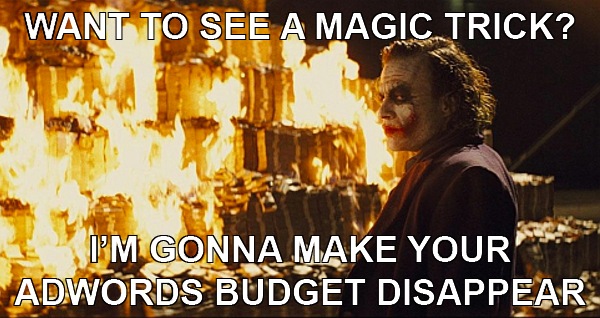How to Make AdWords Work for B2B Marketing
by Jacob Baadsgaard • January 28, 2016
AdWords tends to get a bad rap amongst B2B business owners. And, after auditing over 350 business-to-business AdWords accounts, I can see why.
After all, AdWords is an easy place to lose a lot of money.
This is particularly true in the B2B arena, where your target market tends to be a little more niche. It’s often hard to know which search terms to target and—even when you’ve found a good keyword—turning clicks into conversions and sales can be a real challenge.
Case in point, I recently audited a B2B account that had spent $150,000 on AdWords without producing a single sale. Results like that would make anyone think pay-per-click is a waste of money.

But here’s the thing, if you do it right, AdWords can be one of the best ways to grow a B2B business. In fact, for many of our B2B clients, AdWords is actually their biggest source of B2B leads and sales.
So, what makes the difference for these companies? How do you turn a budget burning account into a marketing superstar?
Winning at AdWords
To be successful at B2B marketing, you have to understand how B2B differs from B2C.
One of the biggest differences between B2B and B2C is the value of a sale. For example, the average eCommerce transaction is worth $85-120. Even if you factor in repeat business, you might make $250 per customer.
Assume a 50% profit margin and you have to keep your cost-per-acquisition (CPA) below $125 just to break even.
On the other hand, lifetime value (LTV) for B2B companies often ranges from $20,000 to over $200,000+.
Even at a profit margin of just 10%, that means that you can pay thousands per sale and still produce a fantastic return-on-investment!
Leverage Your LTV
So, what does that mean for AdWords campaigns? Well, the bigger your profit margin, the more wiggle room you have to figure things out.
For example, even the best-managed campaign is rarely optimized out of the gate. The right campaign setup will save you a lot of money from the get go, but there’s still going to be a learning period between launch and optimal performance.
If you’ve got a small profit margin, that can be a big problem. If you’ve got a $50,000 profit margin, you can still make a lot of money while you get your campaigns up to peak performance.
The ability to leverage profit margin to improve campaign performance gives B2B companies a huge advantage over B2C companies.

For example, last year we started running AdWords campaigns for a B2B company in the insurance industry.
We knew that they would profitable at $150 per lead, but since the client was new to AdWords, we took advantage of their long-term profit margin ($1,000-10,000+) and ran a blast campaign to identify their best keywords.
Our 2-week blitz resulted in a $250 cost-per-lead (CPL), which was unprofitable for the client. However, we used the data from this unprofitable period to identify several highly profitable keywords.
Using those keywords and a killer landing page strategy, we quickly cut their CPL in half. In fact, the campaigns were so profitable that they redefined success for the company—as a result, they’ve since received millions in VC funding!
The moral of the story? By leveraging your LTV, you can produce the kind of campaign results B2C companies only dream of.
Why B2B Companies Struggle With AdWords
So, if B2B is such a great fit for AdWords, why do so many companies have such a hard time getting meaningful results from their PPC campaigns?
The answer is fairly simple—most companies don’t understand how to target and communicate with their potential clients.
Targeting the Right Audience
Who you think you’re targeting isn’t always who you’re actually targeting.
Unlike B2C companies—who usually know which keywords will produce results even before they start advertising—it can often be a challenge for B2B companies to identify the right keywords for their niche.
As a result, many B2B companies bid on search terms that are superficially related to their offering but don’t actually indicate any relevant search intent.
For example, remember that company that had wasted $150,000 on AdWords? $60,000 of that went towards one particular set of keywords with over 150 million searches per month.

Obviously, that’s a lot of potential traffic. However, lots of searches means lots of irrelevant traffic, especially for B2B companies in niche markets.
So, what did this company get for their $60,000?
Absolutely nothing.
Not a single conversion.
Did they get a lot of clicks? Sure. But their traffic wasn’t interested in their product, so no one ever converted.
Less is More
In contrast, here’s what happens when you identify the specific keywords that your customers are using.

Notice how quickly click volume falls off? What’s interesting about this, however, is that the number of conversions stays about the same.
In other words, by increasing the accuracy of your targeting, you eliminate irrelevant clicks (and their associated cost). Then, as you identify additional relevant terms, you build your traffic volume back up—only this time, it comes with more conversions.
All of a sudden, AdWords makes a lot more sense. This particular client is now spending 48% more than when they started with us, but they are producing 900% more leads!

Now, instead of driving a ton of irrelevant traffic, AdWords has become their biggest source of leads and sales!
Speak to the Pain Point
In addition to poor targeting, many B2B businesses struggle to communicate effectively with their audience.
Unfortunately, a lot of businesses assume that everyone cares about all the specifics of their offering. After all, they put an awful lot of work into all those features.
The problem is, most people aren’t looking for a list of features—they are looking for solutions!
Potential customers don’t click on your ad because they want to know all about your product. They click because they think you can solve their problem.

So, if you want people to convert, you need to identify the problem that motivated their search and speak directly to that pain point in your ad and landing page.
Many companies fall into the trap of thinking that their landing page needs to address every possible question or scenario. Let your sales team do that. The goal of a landing page is to show how your offer solves their problem.
If your ads are properly targeted, 90% of your traffic will come to your page with some version of the same pain point in mind. Speak to that pain point and you’ll win their business!
Conclusion
When done right, AdWords can be one of the most effective ways to market your B2B business. It’s an awesome way to get in front of your audience when they are looking for your solution.
That being said, if you do it wrong, AdWords is also a great way to lose a lot of money.
Ultimately, B2B campaigns succeed or fail depending on how well you understand the differences between B2B and B2C advertising and how to leverage the strengths of B2B to create a killer marketing-sales cycle.
By the way, if you’d like me to take a look at your B2B campaigns and give you some feedback, let me know here or in the comments! I’d love to help you unlock the full potential of your campaigns.
You’ve heard my two cents, now I want to hear yours. How have you seen AdWords succeed or fail for B2B marketing?





